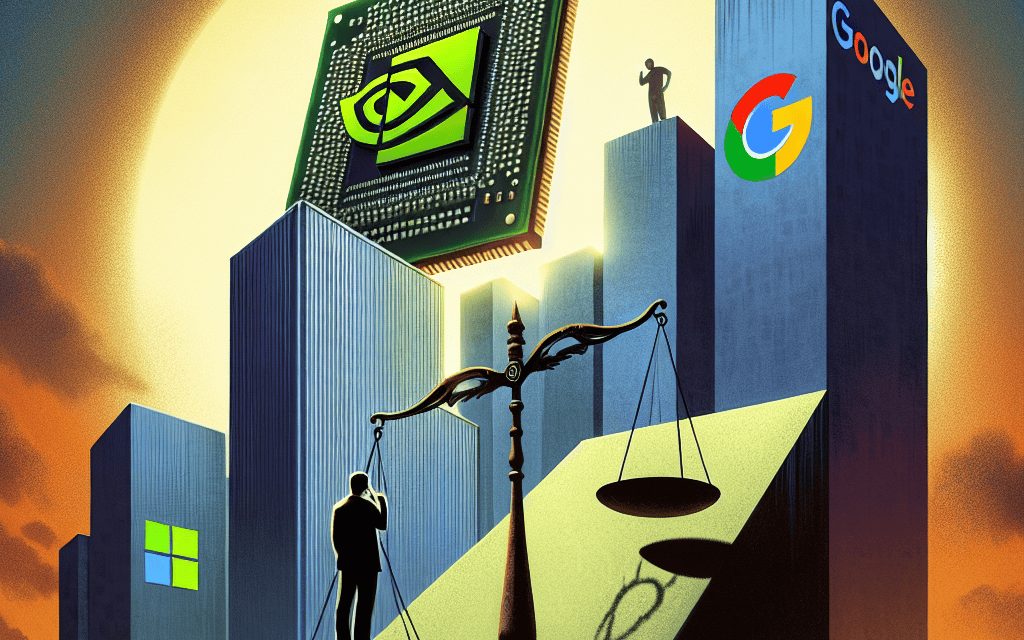“Ride the Wave: Nvidia’s Momentum Surges Amid Tech Titans’ Earnings Season – Is It Your Next Big Investment?”
Introduction
Nvidia, a leading player in the semiconductor industry, is gaining significant traction as it receives robust support from analysts ahead of the earnings reports from tech giants Microsoft and Google. This momentum is fueled by Nvidia’s strong performance in the graphics processing unit (GPU) market and its strategic positioning in the burgeoning fields of artificial intelligence and data centers. As the company continues to innovate and expand its market share, investors are keenly observing whether Nvidia’s growth trajectory will sustain amidst the competitive landscape and macroeconomic challenges. The upcoming earnings announcements from Microsoft and Google could further influence Nvidia’s market dynamics, prompting investors to consider whether now is the opportune moment to invest in this tech powerhouse.
Nvidia’s Strategic Positioning Amidst Tech Giants: An Investment Perspective
Nvidia has been a focal point in the technology sector, capturing the attention of investors and analysts alike. As the company continues to gain momentum, it finds itself strategically positioned amidst tech giants like Microsoft and Google, whose earnings reports are eagerly anticipated by the market. This positioning raises the question of whether Nvidia represents a sound investment opportunity at this juncture.
To begin with, Nvidia’s recent performance has been bolstered by strong analyst support, which has played a significant role in enhancing investor confidence. Analysts have been particularly optimistic about Nvidia’s prospects, citing its leadership in the graphics processing unit (GPU) market and its expanding influence in artificial intelligence (AI) and data center technologies. These areas are not only high-growth sectors but also critical components of the broader technological ecosystem, which further underscores Nvidia’s strategic importance.
Moreover, Nvidia’s innovative approach and robust product pipeline have positioned it as a key player in the ongoing digital transformation. The company’s GPUs are integral to a wide range of applications, from gaming and professional visualization to AI and high-performance computing. This versatility has allowed Nvidia to tap into multiple revenue streams, thereby mitigating risks associated with reliance on a single market segment. As a result, Nvidia has been able to maintain a strong financial performance, even amidst broader economic uncertainties.
In addition to its core business strengths, Nvidia’s strategic partnerships and acquisitions have further solidified its market position. The company’s collaboration with industry leaders, such as its partnership with Microsoft to enhance AI capabilities, exemplifies its commitment to staying at the forefront of technological advancements. These alliances not only provide Nvidia with access to cutting-edge technologies but also expand its reach into new markets, thereby enhancing its growth potential.
As Microsoft and Google prepare to release their earnings reports, the implications for Nvidia are multifaceted. On one hand, strong earnings from these tech giants could signal a robust demand for technology products and services, which would likely benefit Nvidia given its integral role in the tech supply chain. On the other hand, any indication of slowing growth or market saturation could pose challenges, as Nvidia’s fortunes are closely tied to the broader tech industry’s performance.
Investors considering Nvidia as a potential investment should weigh these factors carefully. While the company’s strategic positioning and growth prospects are undeniably compelling, it is essential to consider the broader market dynamics and potential risks. The tech sector is inherently volatile, and Nvidia’s stock price may be subject to fluctuations based on market sentiment and external economic factors.
In conclusion, Nvidia’s momentum, supported by strong analyst endorsements and strategic initiatives, positions it as a formidable player in the tech industry. However, as with any investment, due diligence is crucial. Prospective investors should closely monitor upcoming earnings reports from Microsoft and Google, as these could provide valuable insights into the tech sector’s trajectory and, by extension, Nvidia’s future performance. Ultimately, while Nvidia presents a promising investment opportunity, it is essential to approach it with a balanced perspective, considering both its potential rewards and inherent risks.
Analyzing Nvidia’s Market Momentum: Key Factors Driving Growth
Nvidia, a leading player in the semiconductor industry, has been gaining significant momentum in the market, bolstered by strong analyst support. This surge in interest comes at a time when investors are keenly watching the earnings reports of tech giants like Microsoft and Google, which are expected to have far-reaching implications for the technology sector. As Nvidia continues to capture the attention of market analysts, it is essential to explore the key factors driving its growth and consider whether this momentum makes it a viable investment opportunity.
One of the primary factors contributing to Nvidia’s current market momentum is its leadership in the graphics processing unit (GPU) market. Nvidia’s GPUs are renowned for their superior performance, which has made them indispensable in various high-demand applications, including gaming, artificial intelligence (AI), and data centers. The company’s ability to consistently innovate and deliver cutting-edge technology has solidified its position as a market leader, attracting both consumer and enterprise customers. This strong product portfolio has been a significant driver of Nvidia’s growth, as it continues to expand its reach across different sectors.
Moreover, Nvidia’s strategic partnerships and collaborations have further enhanced its market position. The company’s collaboration with major cloud service providers, such as Amazon Web Services, Microsoft Azure, and Google Cloud, has enabled it to tap into the burgeoning demand for cloud-based AI and machine learning solutions. These partnerships not only provide Nvidia with a steady revenue stream but also reinforce its reputation as a key player in the AI ecosystem. As cloud computing continues to grow, Nvidia is well-positioned to benefit from this trend, further fueling its market momentum.
In addition to its strong product offerings and strategic alliances, Nvidia’s financial performance has also been a critical factor in its recent success. The company has consistently delivered robust earnings, driven by strong sales growth and effective cost management. This financial stability has instilled confidence among investors and analysts alike, leading to positive sentiment around Nvidia’s stock. As a result, many analysts have issued favorable ratings and price targets for Nvidia, further boosting its market momentum.
However, as investors consider Nvidia’s potential as an investment, it is crucial to remain mindful of the broader market context. The upcoming earnings reports from Microsoft and Google are likely to have significant implications for the technology sector, including Nvidia. These reports will provide valuable insights into the overall health of the tech industry and may influence investor sentiment towards Nvidia and its peers. Therefore, while Nvidia’s current momentum is promising, potential investors should carefully evaluate the impact of these earnings reports on the broader market before making investment decisions.
In conclusion, Nvidia’s market momentum is driven by its leadership in the GPU market, strategic partnerships, and strong financial performance. These factors have garnered significant analyst support, positioning Nvidia as a compelling investment opportunity. However, with the looming earnings reports from Microsoft and Google, it is essential for investors to consider the broader market dynamics and potential risks. By doing so, they can make informed decisions about whether Nvidia’s current momentum aligns with their investment goals and risk tolerance.
The Role of Analyst Support in Nvidia’s Recent Surge
Nvidia has recently experienced a notable surge in its stock value, a development that has captured the attention of investors and market analysts alike. This upward momentum can be largely attributed to the robust support from financial analysts who have been increasingly optimistic about the company’s future prospects. As Microsoft and Google prepare to release their earnings reports, the spotlight on Nvidia intensifies, prompting investors to consider whether now is the opportune moment to invest in the tech giant.
Analyst support plays a crucial role in shaping investor sentiment and influencing stock performance. In the case of Nvidia, several analysts have revised their price targets upward, citing the company’s strong position in the burgeoning fields of artificial intelligence and data centers. These sectors are expected to drive significant growth for Nvidia, as its advanced graphics processing units (GPUs) are integral to powering AI applications and managing large-scale data operations. The confidence expressed by analysts is not unfounded; Nvidia’s recent financial results have demonstrated impressive revenue growth and profitability, further bolstering the positive outlook.
Moreover, the anticipation surrounding the earnings reports of tech behemoths Microsoft and Google adds another layer of complexity to Nvidia’s current market dynamics. Both companies are major players in the technology sector, and their performance can have a ripple effect on related stocks, including Nvidia. Investors are keenly watching to see how these earnings reports might impact Nvidia’s trajectory. A strong showing from Microsoft and Google could reinforce the positive sentiment around tech stocks, potentially benefiting Nvidia as well.
In addition to analyst support and the influence of upcoming earnings reports, Nvidia’s strategic initiatives have also contributed to its recent momentum. The company has been actively expanding its product offerings and forging partnerships to strengthen its market position. For instance, Nvidia’s collaboration with leading cloud service providers has enhanced its reach and capabilities in the AI and data center markets. These strategic moves are designed to capitalize on the growing demand for high-performance computing solutions, positioning Nvidia as a key player in the tech industry’s future landscape.
However, while the current outlook for Nvidia appears promising, potential investors should also consider the inherent risks associated with investing in technology stocks. The tech sector is known for its volatility, and external factors such as regulatory changes, geopolitical tensions, and economic fluctuations can impact stock performance. Therefore, it is essential for investors to conduct thorough research and consider their risk tolerance before making investment decisions.
In conclusion, Nvidia’s recent surge can be attributed to a combination of strong analyst support, strategic initiatives, and the anticipation of earnings reports from major tech companies like Microsoft and Google. These factors have collectively contributed to the positive sentiment surrounding Nvidia, making it an attractive option for investors seeking exposure to the technology sector. However, as with any investment, it is crucial to weigh the potential rewards against the risks and to stay informed about market developments. As Nvidia continues to navigate the evolving tech landscape, its ability to maintain momentum will depend on its strategic execution and adaptability to changing market conditions.
Nvidia vs. Microsoft and Google: A Comparative Investment Analysis

Nvidia has been gaining significant momentum in the stock market, bolstered by strong analyst support and a robust performance in the technology sector. As the earnings reports for tech giants Microsoft and Google loom on the horizon, investors are keenly evaluating their portfolios to determine the best course of action. Nvidia’s recent success can be attributed to its strategic positioning in the artificial intelligence and gaming industries, which have seen exponential growth in recent years. The company’s innovative products, such as its advanced graphics processing units (GPUs), have become essential components in data centers and gaming consoles, driving demand and, consequently, its stock price.
In contrast, Microsoft and Google, two of the most formidable players in the tech industry, are also preparing to release their earnings reports. Both companies have a diverse range of products and services that contribute to their financial performance. Microsoft, with its stronghold in cloud computing through Azure, continues to expand its influence in the enterprise sector. Meanwhile, Google, a subsidiary of Alphabet Inc., remains a dominant force in digital advertising and search engine technology. As these companies prepare to disclose their financial results, investors are weighing the potential risks and rewards of investing in each.
When comparing Nvidia to Microsoft and Google, several factors come into play. Nvidia’s focus on AI and gaming positions it uniquely in a rapidly evolving market. The company’s ability to innovate and adapt to changing technological trends has been a key driver of its recent success. Moreover, Nvidia’s strategic acquisitions, such as the purchase of ARM Holdings, have further solidified its position as a leader in the semiconductor industry. This acquisition, although facing regulatory scrutiny, is expected to enhance Nvidia’s capabilities and broaden its market reach.
On the other hand, Microsoft and Google offer a different investment proposition. Microsoft’s diversified portfolio, which includes software, hardware, and cloud services, provides a stable revenue stream and reduces its reliance on any single market segment. This diversification is appealing to investors seeking stability and long-term growth. Similarly, Google’s dominance in digital advertising and its investments in emerging technologies, such as autonomous vehicles and quantum computing, present significant growth opportunities.
As investors consider these options, it is essential to assess the potential risks associated with each company. Nvidia’s reliance on the cyclical nature of the semiconductor industry could pose challenges, particularly if there are disruptions in supply chains or shifts in consumer demand. Additionally, regulatory hurdles related to its acquisitions could impact its growth trajectory. Conversely, Microsoft and Google face their own set of challenges, including increased scrutiny from regulators over antitrust concerns and privacy issues. These factors could influence their operational strategies and financial performance.
In conclusion, the decision to invest in Nvidia, Microsoft, or Google ultimately depends on an investor’s risk tolerance and investment goals. Nvidia’s strong momentum and focus on cutting-edge technologies make it an attractive option for those seeking high growth potential. Meanwhile, Microsoft’s and Google’s diversified portfolios offer stability and resilience in a competitive market. As the earnings reports for Microsoft and Google approach, investors should carefully analyze each company’s financial health, market position, and growth prospects to make informed investment decisions.
How Upcoming Earnings Reports Could Impact Nvidia’s Stock Performance
As Nvidia continues to gain momentum in the stock market, the anticipation surrounding upcoming earnings reports from tech giants Microsoft and Google adds an intriguing layer of complexity to the investment landscape. Nvidia, a leader in the semiconductor industry, has been riding a wave of positive sentiment, bolstered by strong analyst support. This optimism is largely driven by the company’s robust performance in the artificial intelligence and gaming sectors, which have been pivotal in propelling its stock to new heights. However, with Microsoft and Google set to release their earnings reports soon, investors are keenly observing how these developments might influence Nvidia’s stock performance.
To begin with, Nvidia’s recent success can be attributed to its strategic positioning in the AI market. The company’s GPUs are integral to AI applications, making them indispensable for tech companies that rely on advanced computing power. This has not only solidified Nvidia’s reputation as a key player in the tech industry but has also attracted significant attention from analysts who foresee continued growth. Consequently, many analysts have issued favorable ratings for Nvidia, further fueling investor confidence. Nevertheless, the upcoming earnings reports from Microsoft and Google could introduce new dynamics that may impact Nvidia’s trajectory.
Microsoft and Google, both of which are major players in the tech industry, have substantial investments in AI and cloud computing. Their earnings reports are expected to provide insights into the health of these sectors, which are closely linked to Nvidia’s business. Should Microsoft and Google report strong earnings, it could signal a thriving tech environment, potentially benefiting Nvidia by association. On the other hand, if their earnings fall short of expectations, it might raise concerns about the broader tech market, possibly leading to a ripple effect that could dampen Nvidia’s stock performance.
Moreover, the competitive landscape is another factor that investors must consider. While Nvidia has a strong foothold in the GPU market, it faces competition from companies like AMD and Intel, which are also vying for dominance in the AI and gaming sectors. The earnings reports from Microsoft and Google could shed light on how these companies are leveraging their partnerships with various semiconductor manufacturers, including Nvidia’s competitors. This information could influence investor sentiment, as it may highlight potential challenges or opportunities for Nvidia in maintaining its competitive edge.
In addition to these considerations, macroeconomic factors such as interest rates and global supply chain issues could also play a role in shaping Nvidia’s stock performance. The tech industry is not immune to these broader economic trends, and any indications of economic instability in the earnings reports of Microsoft and Google could have implications for Nvidia. Investors should remain vigilant and consider these external factors when evaluating Nvidia’s potential for future growth.
In conclusion, while Nvidia currently enjoys strong analyst support and a favorable market position, the upcoming earnings reports from Microsoft and Google could significantly impact its stock performance. Investors should closely monitor these reports, as they will provide valuable insights into the tech industry’s health and Nvidia’s role within it. By considering both the opportunities and challenges presented by these developments, investors can make more informed decisions about whether to invest in Nvidia at this juncture. As always, a comprehensive analysis of market conditions and company fundamentals is essential for navigating the ever-evolving landscape of tech investments.
Nvidia’s Growth Trajectory: Opportunities and Risks for Investors
Nvidia’s growth trajectory has been a focal point for investors, particularly as the company continues to gain momentum with strong analyst support. This surge in confidence is largely attributed to Nvidia’s strategic positioning in the burgeoning fields of artificial intelligence (AI) and data centers, which have become pivotal in driving the company’s revenue growth. As Microsoft and Google prepare to release their earnings, the spotlight on Nvidia intensifies, prompting investors to consider the opportunities and risks associated with investing in this tech giant.
The company’s robust performance can be traced back to its innovative product offerings and strategic partnerships. Nvidia’s graphics processing units (GPUs) have become essential components in AI applications, providing the computational power necessary for machine learning and deep learning tasks. This has positioned Nvidia as a leader in the AI hardware market, a sector that is expected to experience exponential growth in the coming years. Furthermore, Nvidia’s collaboration with major cloud service providers, including Microsoft and Google, underscores its integral role in the tech ecosystem. These partnerships not only enhance Nvidia’s market reach but also solidify its reputation as a key player in the AI and data center industries.
However, while Nvidia’s prospects appear promising, potential investors must also consider the inherent risks. The tech industry is characterized by rapid innovation and intense competition, factors that could impact Nvidia’s market share and profitability. Companies like AMD and Intel are continuously developing new technologies that could challenge Nvidia’s dominance in the GPU market. Additionally, geopolitical tensions and trade restrictions could disrupt Nvidia’s supply chain, affecting its ability to meet market demand.
Moreover, the impending earnings reports from Microsoft and Google could have significant implications for Nvidia. Both companies are major clients of Nvidia, utilizing its GPUs for their AI and cloud computing services. Positive earnings results from Microsoft and Google could signal continued demand for Nvidia’s products, potentially boosting investor confidence. Conversely, any indication of reduced spending on AI and cloud infrastructure by these tech giants could raise concerns about Nvidia’s future revenue streams.
In light of these factors, investors must weigh the potential rewards against the risks. Nvidia’s strong market position and innovative capabilities present substantial growth opportunities, particularly as AI and data center technologies become increasingly integral to various industries. However, the competitive landscape and external uncertainties necessitate a cautious approach. Diversifying investments and staying informed about industry trends and geopolitical developments can help mitigate potential risks.
In conclusion, Nvidia’s growth trajectory offers both opportunities and challenges for investors. The company’s strategic initiatives and partnerships position it well for future success, particularly in the AI and data center markets. Nevertheless, the dynamic nature of the tech industry and external factors such as geopolitical tensions and competition require careful consideration. As Microsoft and Google prepare to release their earnings, investors should closely monitor these developments to make informed decisions about investing in Nvidia. Balancing optimism with prudence will be key to navigating the complexities of investing in this rapidly evolving sector.
The Future of Nvidia in the Tech Industry: Investment Insights and Predictions
Nvidia, a leading player in the semiconductor industry, has been gaining significant momentum recently, bolstered by strong analyst support. This surge in confidence comes at a time when the tech industry is closely watching the impending earnings reports from giants like Microsoft and Google. As these reports loom, investors are keenly evaluating the potential impact on Nvidia’s future in the tech landscape. The question on many minds is whether now is the right time to invest in Nvidia, given its current trajectory and the broader market dynamics.
To understand Nvidia’s current position, it’s essential to consider the factors driving its recent success. The company has been at the forefront of developing cutting-edge graphics processing units (GPUs), which are crucial for a wide range of applications, from gaming to artificial intelligence (AI) and data centers. Nvidia’s GPUs are renowned for their performance and efficiency, making them a preferred choice for tech companies and consumers alike. This technological edge has allowed Nvidia to maintain a competitive advantage in a rapidly evolving market.
Moreover, Nvidia’s strategic partnerships and acquisitions have further solidified its standing in the industry. The company’s acquisition of Mellanox Technologies, for instance, has enhanced its capabilities in high-performance computing and networking. Such moves have not only expanded Nvidia’s product portfolio but also opened new avenues for growth. As a result, analysts have been optimistic about Nvidia’s long-term prospects, with many raising their price targets for the company’s stock.
However, the tech industry is inherently volatile, and Nvidia is not immune to the challenges that come with it. The upcoming earnings reports from Microsoft and Google are expected to provide valuable insights into the overall health of the tech sector. These reports could influence investor sentiment and, consequently, Nvidia’s stock performance. If Microsoft and Google report strong earnings, it could signal robust demand for tech products and services, indirectly benefiting Nvidia. Conversely, any signs of weakness could raise concerns about the sustainability of Nvidia’s growth.
In addition to external factors, Nvidia faces its own set of challenges. The semiconductor industry is highly competitive, with companies like AMD and Intel constantly vying for market share. Nvidia must continue to innovate and deliver superior products to maintain its leadership position. Furthermore, global supply chain disruptions and geopolitical tensions could impact Nvidia’s operations and profitability. Investors should be mindful of these risks when considering an investment in Nvidia.
Despite these challenges, Nvidia’s long-term growth potential remains promising. The increasing adoption of AI, machine learning, and cloud computing is expected to drive demand for high-performance GPUs. Nvidia’s investments in research and development position it well to capitalize on these trends. Additionally, the company’s focus on sustainability and energy-efficient technologies aligns with the growing emphasis on environmental responsibility in the tech industry.
In conclusion, Nvidia’s recent momentum, supported by analyst confidence, presents a compelling case for potential investors. However, it is crucial to weigh the opportunities against the inherent risks and uncertainties in the tech sector. As Microsoft and Google prepare to release their earnings reports, investors should stay informed and consider how these developments might impact Nvidia’s future. Ultimately, a well-rounded investment strategy that takes into account both the current market conditions and Nvidia’s long-term potential will be key to making an informed decision.
Q&A
1. **What is driving Nvidia’s momentum?**
Nvidia’s momentum is driven by strong demand for its graphics processing units (GPUs), particularly in the AI and data center markets.
2. **How have analysts reacted to Nvidia’s performance?**
Analysts have generally been positive, with many raising their price targets and ratings due to Nvidia’s strong market position and growth prospects.
3. **What role do Microsoft and Google earnings play in Nvidia’s outlook?**
Microsoft and Google are major players in the AI and cloud computing sectors, which are key markets for Nvidia’s products. Their earnings can provide insights into the demand for Nvidia’s technology.
4. **What are the potential risks for investing in Nvidia?**
Potential risks include market volatility, competition from other semiconductor companies, and changes in technology trends that could impact demand for Nvidia’s products.
5. **What are the growth opportunities for Nvidia?**
Growth opportunities for Nvidia include expanding its presence in AI, data centers, gaming, and autonomous vehicles.
6. **How has Nvidia’s stock performed recently?**
Nvidia’s stock has generally performed well, reflecting strong financial results and positive market sentiment.
7. **Should you invest in Nvidia?**
Investment decisions should be based on individual financial goals, risk tolerance, and market analysis. Nvidia presents growth potential, but investors should consider the associated risks.
Conclusion
Nvidia has been gaining momentum, bolstered by strong analyst support, particularly as the company continues to benefit from its leadership in AI and graphics processing technologies. The anticipation of earnings reports from tech giants like Microsoft and Google adds to the market’s focus on the tech sector, potentially influencing Nvidia’s stock performance. Investors should consider Nvidia’s robust market position, growth prospects in AI and data centers, and the broader tech industry’s dynamics. However, they should also weigh potential risks, such as market volatility and competition. Conducting thorough research and aligning investment decisions with individual financial goals and risk tolerance is crucial.





